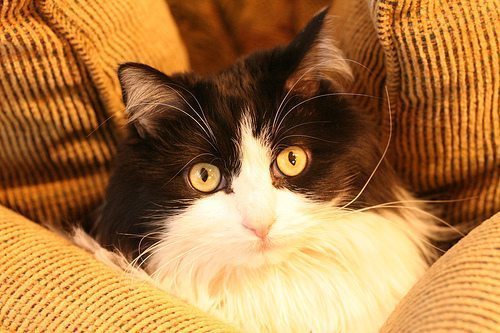Have you ever wondered what your cat was thinking? The cat in the photo is obviously mad, but how your cat feels or what she is thinking is not always so clear. These tips will help you decipher your cat’s behavior.
 What is my Cat Feeling?
What is my Cat Feeling?
Since cats can’t speak to us like we speak to each other they use body language to let us know how they are feeling. Different parts of your cat’s body will communicate different things to you.
Your Cat’s Tail:
You can tell a lot about how your cat is feeling by how she is moving her tail. If your cat’s tail is puffed out it may be feeling angry. If her tail is swaying back and forth she may be feeling uncomfortable or annoyed. If your cat’s tail if swaying rapidly she’s very agitated. If your cat’s tail is twitching she is excited and curious.
Your Cat’s Legs:
Those cute little legs can tell you a lot about how your cat is feeling too. If your cat’s legs are stretched out she is feeling confident and possibly aggressive. When she bends her forelegs she doesn’t want to fight, but will if necessary. If your cat’s hind legs are bent it means she is feeling timid. Your cat is submitting when her body is shrunken with her legs tucked underneath her.
Your Cat’s Ears:
A cat’s ears are a telltale sign of how they are feeling. When the ears are back and the body is low your cat is not happy with the situation or are showing aggression. If you are petting your cat and the ears go back, take note because she is probably not happy with where you are petting her and any prolonged aggravation could lead to aggression. When her ears are pricked up she is interested in something and attentive.
Cat Speak:
Cats vocalize their needs from a very young age. Kittens meow (surprisingly loudly) to get their mother’s attention. Cats make a strange howling sound at nighttime. It doesn’t mean they are lonely or in pain, even though it sounds like they are. Cats will hiss when angry, annoyed or scared – some experts believe the hiss developed as a survival tactic. Animals have been known to mimic other animals and cats may have learned to hiss from snakes claims Animal Planet. Cats will make a chattering sound when they see a bird – possibly out of excitement of seeing a prey and the frustration of not being able to finish the hunt. Finally, cats purr when content and happy.
The more you are around your cat, the better you will be able to see what your cat is feeling and thinking. Interacting with your cat will also help you better understand her. You will be able to tell when she is hungry, needs attention, wants to play, and when she just wants to be left alone.
Photo: Courtesy of Buddhika Gammudali









